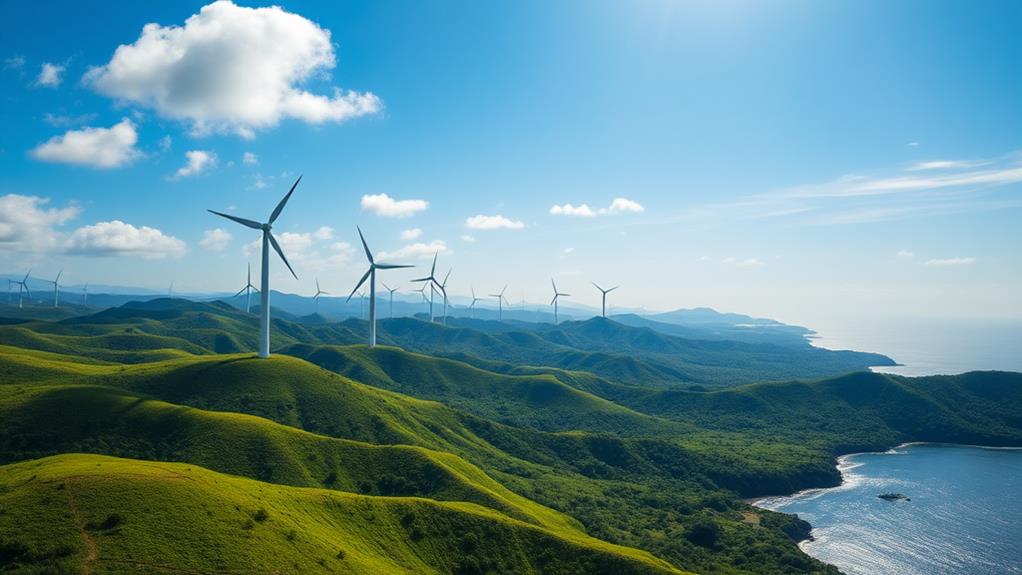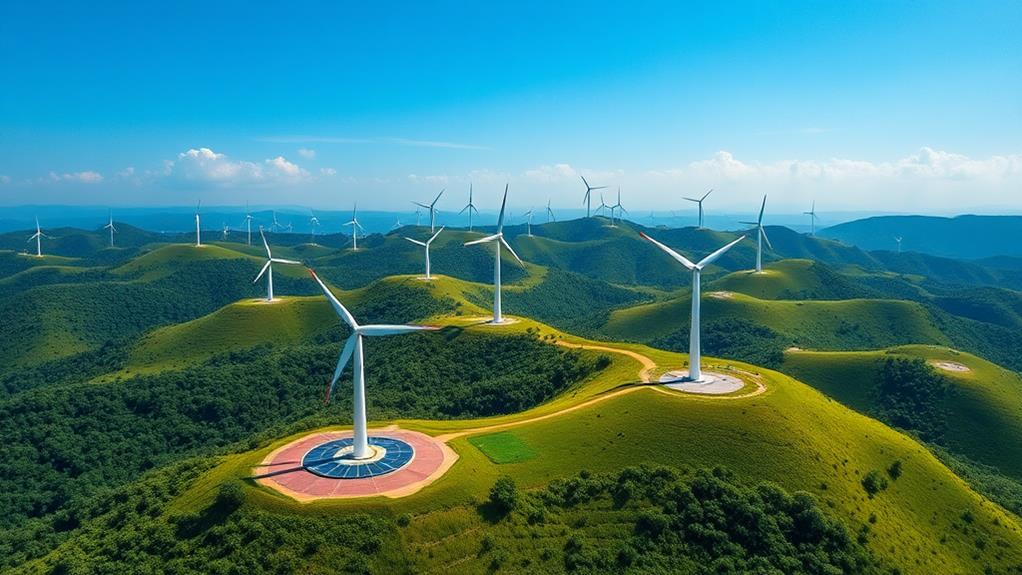The Philippine wind energy industry is focused on developing wind farms to achieve the goal of 35% renewable energy by 2030.
Strategic locations, such as Currimao and Batangas, show potential for over 41,000 MW of energy. Notable projects, like the Bangui and Pililla Wind Farms, help boost local economies and create jobs.
There are challenges, including high initial investments and regulatory hurdles. However, government support and plans for offshore development suggest a bright future.
These efforts mark a significant shift toward sustainable and independent energy production in the Philippines.
Overview of Wind Energy

Wind energy is important for the Philippines' renewable energy efforts. The country uses turbines to capture wind energy, which helps improve its energy supply. For example, the Bangui Wind Farm has a capacity of 33 MW.
The Philippines plans to reach a 35% renewable energy supply by 2030, showing its dedication to sustainable growth.
Offshore wind development is promising too. There are strategic ports in Currimao, Batangas, and Jose Panganiban that can support this growth. Together, these ports could generate over 41,000 MW of wind energy.
This positions the Philippines as a significant player in the renewable energy market. Using wind energy boosts energy independence and creates jobs, contributing to economic growth.
Investing in wind energy helps the Philippines meet global climate goals by reducing carbon emissions. This shift is crucial for building a cleaner and more sustainable future for the nation.
Key Wind Farms in the Philippines
The development of wind farms in the Philippines shows the country's focus on renewable energy.
Bangui Wind Farm is the first and largest in the country, with 20 turbines that have a total capacity of 33 MW. This wind farm plays an important role in providing renewable energy.
In Rizal, the Pililla Wind Farm has 53 turbines that generate 54 MW of power. This farm not only boosts energy supply but also creates jobs for the local community.
The San Lorenzo Wind Farm in Guimaras has a capacity of 36 MW, which helps improve the national energy grid.
The largest wind farm in the Philippines, located in North Luzon, consists of 32 turbines with a combined capacity of 160 MW. This project aims for 35% of the country's energy to come from renewable sources by 2030.
A new wind farm project in Ilocos Norte, started in July 2023, will add 70 MW of energy with 14 turbines. This initiative emphasizes the Philippines' ongoing investment in clean energy.
Economic Benefits of Wind Energy

Investing in wind energy has significant economic benefits for local communities in the Philippines. It not only helps the environment but also boosts the economy.
Job Creation: Wind energy projects can create about 24,000 jobs during their construction and operation. For example, workers are needed for building wind turbines and maintaining them.
Energy Security: Wind energy helps the Philippines become more energy independent by reducing the need for imported fossil fuels. This means that the country can rely more on its own resources.
Stabilized Electricity Prices: More wind energy can lead to stable electricity costs. This is beneficial for Filipino households because it helps them manage their monthly expenses better.
Local Economic Boost: The Bangui Wind Farm significantly contributes to the local economy, providing around 40% of Ilocos Norte's economic activity. This includes increased tourism and job opportunities in the area.
Reduced Healthcare Costs: By lowering carbon emissions, wind energy can lead to healthier communities. This may result in reduced healthcare expenses for families, as cleaner air can decrease health problems.
These points show that wind energy is a smart investment. It creates jobs, enhances energy security, stabilizes electricity prices, boosts local economies, and can lower healthcare costs.
Embracing wind energy can improve the quality of life for many Filipinos.
Environmental Advantages of Wind Power
Harnessing wind power offers important environmental benefits that support the Philippines' goals for sustainability and lower carbon emissions.
Wind energy significantly reduces greenhouse gas emissions, which helps lower the country's carbon footprint. This shift to wind power is essential for fighting climate change and provides a reliable, renewable energy source to replace fossil fuels.
Using wind energy also reduces air pollution, which can lead to fewer health problems in local communities. This improvement helps create a healthier ecosystem.
Additionally, wind farms can promote biodiversity by offering habitats that coexist with renewable energy structures. This is better for the environment compared to traditional fossil fuel extraction methods that often harm ecosystems.
Challenges Facing Wind Energy Development

Wind energy development in the Philippines faces several key challenges that can impact project success.
These challenges include:
- High initial investment costs: Building wind energy infrastructure can cost between USD 2 million and USD 3 million per megawatt (MW). This high cost can make it difficult to secure funding and support for new projects.
- Regulatory hurdles: The process for getting permits can be very slow. Unclear guidelines about regulations can lead to delays in project timelines, making it harder to get projects started.
- Geographical challenges: Many suitable sites for wind farms are in mountainous areas. Building in these locations can be risky due to steep slopes and extreme weather conditions, which can complicate construction efforts.
- Integration complexities: Adding wind energy to current power grids isn't simple. It needs advanced systems to ensure stability, which can be both technically difficult and costly.
- Community acceptance: Local communities may oppose wind projects. Community awareness and support are essential, as opposition can lead to delays or cancellations of projects.
These issues affect the ability to develop wind energy and slow down the Philippines' shift toward sustainable energy solutions.
Overcoming these challenges requires strong cooperation from all stakeholders involved.
Opportunities for Future Growth
The Philippine wind energy sector is ready for major growth. This growth is due to three important offshore development zones: Manila Bay, Tayabas Bay, and Guimaras. These areas have high potential for offshore wind energy, which can help the country become a leader in renewable energy.
Major ports like Currimao, Batangas, and Jose Panganiban are being improved to support offshore wind projects, which could produce over 40,000 megawatts (MW) of power.
The Philippine government will start bidding for offshore wind projects by the end of 2024. A Green Energy Auction is expected in Q2-2025. This plan supports the goal of getting 35% of the country's energy from renewable sources by 2030.
New technology in wind energy will help connect offshore wind power to the power grid.
Additionally, the growth in offshore wind projects is projected to create around 24,000 jobs during both the building and operational stages. These jobs will help the local economy and improve the country's energy independence.
The future of wind energy in the Philippines looks promising, with many opportunities ahead.
Role of Government Support

The growth of the wind energy sector in the Philippines relies heavily on strong government support and strategic initiatives. The government plays a vital role in creating a favorable environment for investment and development in wind energy.
For example, policies that simplify the permitting process and promote competitive bidding, such as the Green Energy Auction, help producers succeed in the renewable energy market.
Key elements of government support include:
- Investment-friendly policies that attract both local and foreign investors.
- Collaboration between the Department of Energy (DOE) and the Philippine Ports Authority (PPA) to improve port infrastructure for offshore wind projects.
- Support for feasibility studies to assess the potential for offshore wind energy in areas like Currimao and Batangas.
- A commitment to achieving a 35% renewable energy supply by 2030, highlighting the role of wind energy in the national energy plan.
- Programs to educate stakeholders about the advantages of wind energy, encouraging wider acceptance and involvement.
How Does Solar Energy Impact the Development of Wind Farms in the Philippines?
The solar energy growth potential in philippines has significant impact on the development of wind farms in the country. With the increasing focus on renewable energy sources, the potential for solar energy is driving investment and infrastructure development, creating opportunities for the growth of wind farms as well.
Community Engagement Strategies
Effective community engagement strategies are crucial for wind energy projects in the Philippines. Informational campaigns and workshops can help raise awareness about the benefits of wind energy and address local concerns. For instance, the Bangui Wind Farm project successfully involved community leaders and NGOs, which built trust and acceptance.
Participatory decision-making allows community members to share their opinions and help plan projects. This not only makes projects more sustainable but also increases local support. Highlighting job creation in construction and maintenance of wind farms can show the economic benefits to the community.
Lastly, continuous communication and transparency throughout the project is essential. This helps build strong relationships with communities, ensuring their ongoing support and allowing for quick responses to any issues.
Future Trends in Wind Energy

The Philippines is moving toward a sustainable future with the help of wind energy. The government plans for 35% of its energy to come from renewable sources by 2030. Wind energy will play a key role in achieving this goal.
Several initiatives will support this growth. First, new wind technology will make wind turbines more efficient and capable of producing more energy. Second, ports in Currimao, Batangas, and Jose Panganiban will be repurposed to improve the logistics needed for wind projects. Third, specific areas in Manila Bay, Tayabas Bay, and Guimaras have been identified for offshore wind developments.
Additionally, a Green Energy Auction is scheduled for the second quarter of 2025. This auction will encourage competition among companies in the renewable energy sector. The Philippines aims to be a regional leader in renewable energy, which will help the country meet its energy goals.
By focusing on offshore wind potential, the Philippines can greatly improve its energy supply. This shift not only helps the environment but also makes the country more attractive in the regional energy market.
Questions and Answers
How Many Wind Farms Are There in the Philippines?
The Philippines has approximately 10 operational wind farms. These wind farms are located in various regions to improve energy capacity. They play an important role in renewable energy integration, which helps to make the country's energy supply more reliable and sustainable.
What Is the Wind Energy Project in the Philippines?
The wind energy project in the Philippines uses renewable energy policies to improve the country's energy system. These projects help to reduce environmental impact by using clean energy instead of fossil fuels. For example, wind turbines convert wind into electricity, which lowers greenhouse gas emissions. They also boost energy security by providing a stable energy source that can reduce dependence on imported fuels. Overall, these initiatives support the country's efforts toward sustainable energy and contribute to global climate goals.
What Are the Problems With Wind Energy in the Philippines?
Developing wind energy projects in the Philippines faces grid integration challenges. This means that connecting wind energy to the existing power grid can be difficult. For example, the grid may not have enough capacity to handle the additional electricity from wind farms.
Another issue is environmental impact concerns. Wind turbines can affect local wildlife and ecosystems. For instance, birds and bats are at risk of collision with turbine blades, which can lead to declining populations.
There is also community opposition to wind energy projects. Some local residents may be worried about noise from turbines or changes to their landscape. For example, people living near proposed wind farm sites might not want the view of large turbines.
These challenges make it important to address these issues for successful wind energy development.
Is the Philippines Going to Offshore Wind Auction 2024?
The Philippines is starting an offshore wind auction in 2024. This decision shows the country's potential for offshore wind energy. It will also create investment opportunities. The goal is to boost renewable energy development and support economic growth.